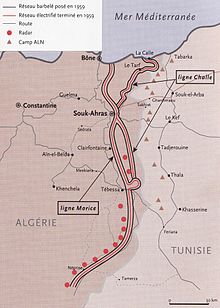User:Whatever748/Battle of the Borders (Algerian war)
| Battle of the Borders (Algerian war) | |||||||
|---|---|---|---|---|---|---|---|
| Part of the Algerian war | |||||||
 The Morice line | |||||||
| |||||||
| Belligerents | |||||||
|
|
Support: | ||||||
| Commanders and leaders | |||||||
|
|
Houari Boumediene | ||||||
| Units involved | |||||||
French Air Force Dragoons Armored units |
| ||||||
| Strength | |||||||
|
5,000 men Heavy weaponry Several dozen aircraft | 5,000-10,000 men | ||||||
| Casualties and losses | |||||||
|
364 dead 700 wounded |
2,400 casualties 300 POW 3,300 captured weapons[1] | ||||||
The battle of the borders,
Background
In the month of january 1958, the Algerian insurrection has been active for 3 years. Outside of the country, the FLN was helped by Egypt (then United Arab Republic),[3] Morocco, and especially by Tunisia, which ever since it's independence in 1956, served as a base for FLN militants.
Confronted with a situation which became more and more delicate as days passed, the French Army searched for more and more complicated solutions to the increasing amounts of weapons deliveries from Tunisia ever since the country became indpendent in 1956. In the Autumn of 1957, more than 2,000 weapons were smuggled through the Tunisian border per month. The French government tried their best to excercise as much pressure as they could on the Tunisians in vain. The only possible solution became military. The main goal of the French army became the interception and destruction of all weapons which traversed the Morice line, which spanned 460 kilometers, from the Mediterranean Sea to the Sahara.[5]
Conception
On january 1958 general
These five regiments patrolled on the main points of infiltration, in addition to the normal protection system of the line. Four regiments in front of it, six mechanized regiments in charge of the "Spike strips" and six regiments of the sector dealt with the land around the line. Three Helicopter detachments were made available at Guelma, Tébessa and Bir el-Ater. On demand, light support aircraft detachments would be sent, armed with North American T-6 Texans, or heavy ones with naval Corsairs could be supplied from the airbases of Bône and Tébessa.
The battle
The main theater of operations were defined as the main areas where ALN troops would penetrate from, such as Ghardimaou, either side of the mountains around Medjerda, from Souk Ahras and Guelma. The forces disposed by the National Liberation Army (ALN) around La Calle, Souk Ahras and the Ouenza iron mine, from its base in the East, were three battalions each composed of three katibas of 250 to 300 men. In the first battle of Souk Ahras, from 1 february to 8 february 1958, these units faced the 5 paratrooper regiments, without counting the units positioned near the spike strips assuring the security of the Morice Line, spread over 700 kms, and doing their role of notifying HQ about any ALN penetration.
On 16 february 1958, the new plan finally brough it's fruits. The paratroopers, helped by the 18th dragoon regiment caught two katibas which tried to cross the line. This success led to 200 hostile combatants, killed or imprisoned, and the recovery of a large amount of important arms. Between 25-26 february, to 4 march, two other katibas were caught the same way.[6]
In the centre of the French
Only the northern regions still remaining, a large amount of ALN forces united. As it has been doing since January 21, it kept harassing French positions on the border (which caused the majority of french casualties), while the FLN additionally reinforced it's positions with the 4th faïlek which had 900 to 1,000 men. For the ALN high command, it was imperative to act quickly as both moral, and logistics of the inner wilayas left much to be desired.
From 28 April to 3 May, more than a thousand combatants embarked on a new offensive to try to get two katibas to go reach wilayas I and II and a communication unit intended for wilaya I. This Second Battle of Souk Ahras took place in the Jebel of EI-Mouadjène, and included heated melee between Algerians and the 9th RCP of colonel Bouchoud.[7] Only a third of the initial ALN combatants made it past the border, uniting with Wilaya III in the heart of Kabylia.
Ambush of Guelma
On 28 or 29 May, French commander Pierre Jeanpierre was pursuing ALN guerillas with his paratrooper division.[8] Unknown to him this was a trap set up by the FLN. While pursuing them, his helicopter was shot down by a missile launched by hidden Algerian troops.[9] The death of this esteemed French commander was one of the main successes of the ALN during the battle of the borders, in a military campaign which was otherwise a defeat.
Aftermath
After the battle the number of weapons smuggled through the border became lower and lower. By 1959 only 200 weapons were smuggled through the border per month, and by 1960 this number dropped to only 60.
In the following months, a similar situation developed on the Moroccan border. Thanks to this, the interior elements of the ALN found themselves isolated from the outside, and trapped inside the mountains of Algeria. A situation which was perfect for plan Challe.[9]
References
- ISBN 978-2-7381-6441-4.
- ISBN 978-1-107-13504-8.
- ^ On Record. Keynote Publications. 1968.
- ISBN 978-1-4488-1861-7.
- ^ a b Historia magazine: la guerre d'Algérie (in French). Tallandier. 1974.
- ^ Dufour 2004, p.103
- ^ Bataille de Souk-Ahras, on Algérie1.com, 26 avril 2016
- ISBN 978-1-84994-518-9.
- ^ ISBN 978-2-915118-17-9.
Category:Conflicts in 1958 Category:Battles involving France Category:Battles involving Algeria Category:Algerian War Category:Battles of the Algerian War
